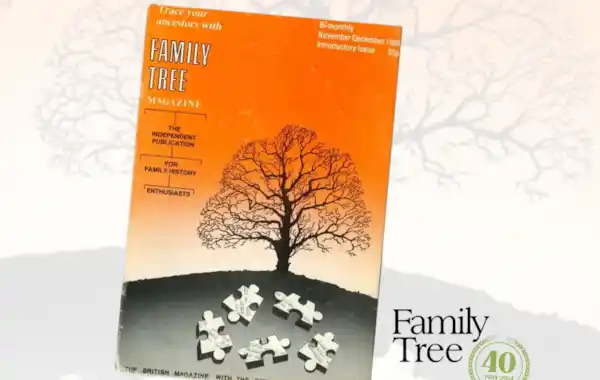27 October 2024
|
Family Tree magazine is celebrating its 40th anniversary throughout November. Find out more about the magazine and its history, and how the genealogy world has changed over the decades.
This autumn, 2024, Family Tree celebrates 40 years of publication.
How did Family Tree magazine UK start?
Former paramedic and fish & chip shop owner Michael Armstrong, founder of Family Tree, had thought long and hard about starting a family history magazine. He was a keen family historian himself, and had made enquiries among those involved in the family history scene at the time, to see whether it would be an idea well-received.
On launch, the first issue of Family Tree (November/December – it was to be bi-monthly initially) was a 32-page publication costing 85p.
Sign up to the Family Tree newsletter and receive our friendly, inspiring update every Monday!
A mini timeline of family history organisations
This was a world, as many of us will recall, five years prior to the invention of the World Wide Web – something now so central to the way in which many people research, collaborate and enjoy genealogy.
Key elements in the family history world were long and well established – such as:
- General Register House, Edinburgh, completed in 1788, and The National Archives, London (formerly the Public Record Office established 1838)
- the Public Record Office of Ireland (est 1867, now part of the National Archives of Ireland)
- FamilySearch (est 1894 – and called at the time the Genealogical Society of Utah)
- the National Library of Wales (est 1907)
- the Society of Genealogists (est 1911(
- the Association of Genealogists and Researchers in Archives (1968)
- U3A (1973); Family History Federation (est 1974, formerly the Federation of Family History Societies)
- the Institute of Heraldic and Genealogical Studies established (1982)
- and Ancestry (1983 – officially going online 13 years later in 1996)
Many individual family history societies were already established too, and further groups would follow.
Family history tech milestones
The years following the first publication of Family Tree have seen transformative developments in family history technology and tools:
- from the Family Tree Maker family software first published in 1989
- to the establishment of FamilyTreeDNA a decade later and officially launched in 2000 with the introduction of consumer DNA tests for genealogy: 12 STR marker tests
- In 2007 23andMe (est 2006) became the first company to offer saliva-based direct-to-consumer autosomal DNA tests
Family history standards & education
Meanwhile the dedication of genealogists to develop the field has included a host of valuable initiatives – from the publication of the Genealogical Proof Standard (the five-step process to help work towards rigour in research) by the Board for Certification of Genealogists in America in 2000; to the launching of post-graduate university courses by the University of Strathclyde (the Post-Graduate Certificate course was established in the academic year 2006/7 with the Diploma the next year) and just last year the Strathclyde Institute for Genealogical Studies was founded.
Pharos Tutors courses (est 2005) have made genealogy education extremely accessible, as have the programmes of the SoG and IHGS, and dedicated tools such as those from DNAPainter continue to equip family historians with the kit needed by today’s researchers.
Family history volunteer heroes
Vast volunteer projects have seen collaboration bring genealogy data to the public in a freely accessible way, such as the birth, marriage, death, census and parish register indexes from FreeBMD, FreeCen and FreeReg – Free UK Genealogy (est 1998).
Cyndis’ List of more than 317,000 useful genealogy links is a directory of global family history interest that has been growing since 1996, while GENUKI – established the previous year has well over 110,000 web pages of specific UK and Irish genealogy interest.
See the Family History Handbook, coming soon!
For every organisation mentioned there are literally hundreds more that could be covered.
See the latest issue of the Family History Handbook 2025, due to be published in December 2024: if you have a family history organisation, publication, tool, resource, etc, that you would like including in the Handbook or within the pages of a future edition of Family Tree, please email [email protected] by 10 November 2024 and we will be very happy to consider your proposal.
How does Family Tree magazine help family historians?
Over the years and decades organisations and individuals have striven to make genealogy archives, resources, knowledge, and skills available to anyone interested in tracing their family story, and continue to do so.
As part of this Family Tree is proud to publish experts in their fields, in every issue, who generously share the fruits of their experience so that fellow family historians may benefit. Yet it’s very much a readers’ magazine too, and the reader stories, questions and letters are intrinsic to the sense of family history community found within the pages of the magazine.
40 years on and these are values that Family Tree still stands by too. In addition to the magazine, the Family Tree brand publishes workbooks, and runs courses, webinars and the online family history membership, Family Tree Plus (est 2022).
Get FREE family history enews
We thank you for your interest in and support for Family Tree and invite you, if you have not already done so, to sign up to our free enewsletter (just complete the quick form below) as – throughout November 2024 – we will be running celebratory activities to remember our 40 years. We look forward to you joining us.








